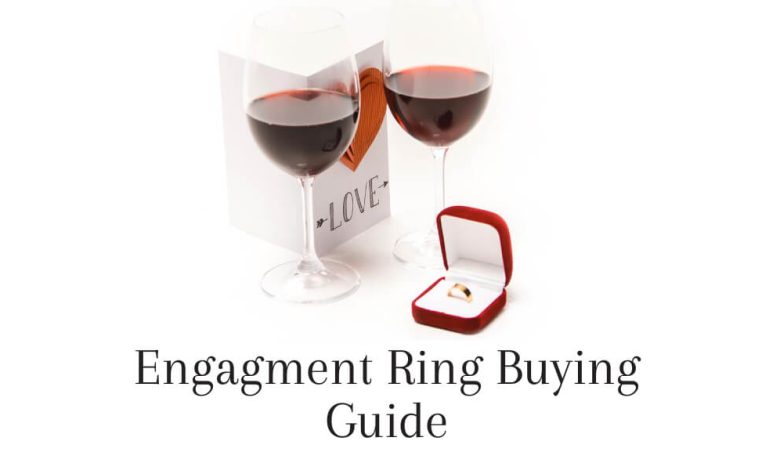How To Choose Diamond For Engagement Ring In 2022?

The hard part about buying an engagement ring is choosing which type of diamond is right for your girlfriend. With so many different kinds of diamonds available, you could spend weeks comparing spec sheets with jewelers until you get the perfect one. But if you’re looking to save time and money on your engagement ring, there are a few things that will help narrow down your search.
To start off, it’s important to know what kind of diamond you want in your engagement ring. There are two main types: lab-grown diamonds and natural diamonds. Alternatively, if you want something cheap, you can choose moissanite or cubic zirconia.
Choose A diamond Type
When buying an engagement ring it is important to choose your diamond-type first. If you have never bought an engagement ring before then this may seem like a daunting task but once you understand how each diamond type works you’ll be able to make an informed decision. There is a lab-grown diamond from a finegrown diamonds company that sells man main diamonds sell all over the world including the United Kingdom, USA, Canada, and Australia.
These are the types of diamonds from which you can choose depending on your budget, taste, and preference.
Natural Diamond
Natural diamonds are mined from the earth and are regarded as the rarest form of diamonds. They’re also by far the most expensive. Although their appearance looks similar to lab-created diamonds, there is a very subtle difference, which is how they were originally formed.
If you are thinking about buying a natural diamond then you have to expand your budget for getting a better quality diamond. Because natural diamonds are rare, they are not available in all shapes and clarity. And a better quality diamond can cost you a lot, you will be paying a lot more for what is essentially the same product.
Natural diamonds come in different colors and clarity depending on the diamond’s origin. In addition, they can also have other characteristics such as hair-lines, which is when a diamond has cracks on the surface of it. So if you’re buying natural diamonds, you should consider looking at those that are more expensive.
Lab-grown Diamond
Lab-grown diamonds have been around since the 1950s. They are grown in labs using high pressure and heat to create synthetic stones that look just like real ones and have the same characteristics. The biggest advantage of these diamonds is that they don’t cost much more than their natural counterparts.
If you are looking for a more affordable engagement ring then lab-created diamonds are great options. Because lab-created diamonds come in all different colors and clarity, you can choose the best quality with a larger carat and at a lower cost as compared with mined diamonds. They also share the same characteristics as natural diamonds such as that they are formed from carbon.
If you’re buying a lab-created diamond, then you don’t have to spend much time trying to find the right one. There are so many varieties and different prices that you’ll be able to get what you want right away.
Moissanite
Moissanite is another option for people who want a cheaper alternative to a diamond. They look beautiful and shiny at first. It’s made up of silicon carbide crystals and is often mistaken for a diamond because of its colorless appearance. But unlike a diamond, moissanite doesn’t contain any carbon. This means it may scratch, break, or fade over time as they are not real diamonds. Moissanite is usually sold as a white stone, but some manufacturers offer colored versions too. To ensure that you’re getting good-quality moissanite, check out the certificate of authenticity. You can buy moissanite rings online and in stores.
It costs way less than natural diamonds, and lab-grown diamonds. If you are looking for a cheap engagement ring, then moissanite is definitely an option worth considering. The only downside is that moissanite does not last forever. As they are made of silicon carbide, they do not have the same durability.
How to Pick a Diamond?
After selecting a diamond type, the next thing you should do is pick the perfect diamond for your ring. You have to make sure that it’s the right size, color, and clarity. There are many factors that go into making a perfect engagement ring, but it’s best to base your decision on a variety of things, so you can get the best possible value.
When it comes to selecting the right diamond for your engagement ring, It’s important that you take into consideration these elements. You should also find out what type of diamond is the most popular or will be in demand in the future. To find out what all these mean and here’s a quick breakdown of each thing you should consider.
Choose Your Diamond Shape
The shape of your diamond has a huge impact on how your diamond looks when it’s set in your ring. A round diamond is probably the most common shape, but there are other shapes available too. Some of them include square, heart, pear, marquise, emerald cut, princess, oval, radiant, cushion, and baguette. The shape of your diamond will determine which setting style is best suited for your ring. You should select a diamond based on the shape that matches the design of your ring. You can always change the shape later if you decide you want something else.
Select Your Carat Weight
A diamond’s carat weight determines how big it is. The bigger the diamond, the higher the price. A 1/2 carat diamond is smaller than a 3/4 carat diamond. So if you want to save money, you might want to opt for a smaller diamond. However, a large diamond can add drama to your engagement ring. When choosing a diamond, you need to think about the overall look of your ring. Do you prefer a simple band with no fancy details? Or would you rather have a more elaborate setting? You’ll have to weigh the pros and cons of both options before deciding what kind of diamond you want. Remember: the larger the diamond, the more expensive it is.
Narrow Down on Cut Quality
Cut quality refers to the way a diamond was polished. There are five main categories of cuts: excellent, ideal, very good, good, and poor. Each one offers different benefits. Excellent cut diamonds are considered the highest quality. They are perfectly symmetrical and have high brilliance. Ideal cut diamonds are slightly asymmetrical and offer moderate brilliance. Very Good cut diamonds are slightly off-center and offer lower brilliance. Good cut diamonds are slightly askew and offer low brilliance. Poor cut diamonds are completely irregular and offer little to less brilliance. If you’re looking for a specific cut, you should choose the highest quality cut you can afford.
Choose the Best Clarity
You should have a good understanding of the grading criteria for clarity. When buying online, you can use the GIA clarity documents as a quick reference guide. Clarity refers to the purity of the diamond. Diamonds with high clarity are very pure and have few imperfections. These diamonds tend to be more valuable than those with lower clarity. The most common types of clarity are I1 (perfect), SI1 (very slightly included), and VS1 (very slight inclusions).
Determine Color Grade Range
Color is another factor that affects the value of your diamond. White diamonds are the most desirable because they reflect light beautifully. Yellow diamonds are also popular. A diamond color scale ranges from D color to Z color. The letter grade represents the range of colors within the diamond. The higher the number, the whiter the diamond. The letters represent the following: D, E, F is totally colorless, G, H, I, J is also near-colorless, K, L, M is lightest yellowish-white, N, O, P is light yellow, Q, R, S is near yellow, T, U, V is yellow, W, X, Y, Z is a darker yellowish color.
Ring Setting Styles
There are many ways to set a stone into an engagement ring. You can get creative and try out some new settings or stick to tried and true styles. Most people like to keep things traditional so they know exactly what their ring will look like. Styles range from three-stone settings to wedding band settings. Like the diamond, the engagement ring setting will also have an impact on how your ring looks. It should match the style of your engagement ring. You can always change or upgrade your setting later if you want to keep your original design but upgrade the setting style.
Here’s a list of the most popular settings from which you can choose:
- Prong Setting & Solitaire Setting: The most popular settings are prong and solitaire settings. These two different settings give you a great deal of flexibility when it comes to design. For both of these settings, the side stones are also set into prongs instead of bezel or channel settings. You can always add small diamonds around the solitaire diamond for a little extra sparkle.
- The Tiffany Setting: The Tiffany setting is a classic and well-known style. You can select your own center stone and have it set into a channel setting. You can also add a smaller diamond as an accent gemstone in the center of the ring. This setting is ideal for large center stones such as pear, round, and princess cut diamonds.
- Bezel Setting: The bezel setting consists of a thin band that goes around your diamond. You can select the size of your band, but it will always be smaller than the side stones to give them some breathing room. Bezel settings are ideal for diamonds that do not need a lot of sparkles because they won’t catch and reflect light like some of the other settings.
- Tension Setting: A tension setting is similar to a bezel setting except there is no band surrounding the diamond. Instead, the sides of the diamond are held together by tiny wires. This setting gives you more freedom to customize your ring.
- Channel Setting: There is a wide band with a groove running along the top edge of the diamond. The side stones are then set into this groove. Channel settings are perfect for smaller diamonds that don’t need much space between the stones.
- Pavé Setting: This setting has a unique shape. There is a narrow band at the bottom of the diamond that holds the stones in place. Then, there is a wider band above the first one.
- Halo Setting: A halo setting is a very simple setting where the side stones are all set into a circle of the center stone. Halo settings are usually used for smaller stones that don’t require a lot of space.
- Cathedral Setting: A cathedral setting is similar to a halo setting except the stones are all set into the same circle. The difference is that the side stones are set into a larger circle that surrounds the main stone. Cathedral settings are often used for large center stones.
- Three-Stone Setting: This setting is ideal if you want to show off a few different colors of stones. In this setting, there is a central stone surrounded by two smaller stones. You can use any color combination you want. You can even mix up the sizes of the stones.
- Antique/Vintage Setting: An antique or vintage setting is a relatively recent trend. There are three types of antique settings: a stepped setting, an open setting, and a traditional setting. The steps are just that: small steps in the metal frame where the three stones fit in. Some antique settings also have an open setting with one side stone laying flat on top of the other side stone.
- Cluster Setting: In a cluster setting, each stone is clustered together so they look like one big stone. Cluster settings are typically used for larger stones that don’t need a lot of space. They are also good for people who prefer a simpler setting.
- Eternity Band : An eternity band is a type of wedding band that looks like a bracelet. It’s made from precious metals such as gold, platinum, palladium, silver, and white gold. The band is designed to go around the finger rather than being worn on the hand. Eternity bands come in many styles including classic, modern, and contemporary.
Ring Metal Types
Metal rings are available in several different materials. Each material offers its own benefits and drawbacks. Here is a list of the most common ones.
Gold
It is the most popular metal for engagement rings. Gold is durable, easy to clean, and hypoallergenic. If you’re looking for something inexpensive but still beautiful, consider buying a yellow gold ring instead. Yellow gold is less expensive than white gold.
White Gold
Similar to platinum, but it’s rare. It’s also considered to be a softer metal than platinum. This makes it easier to engrave and polish. Because white gold is more affordable than platinum, it’s becoming increasingly popular.
Platinum
This metal is a hard, shiny metal that is strong and resistant to corrosion. Platinum is also hypoallergenic and easy to care for. However, platinum isn’t as soft as white gold, which means it may scratch more easily.
FAQs:
What is the diamond engagement ring price?
The average cost of an engagement ring ranges between $2,500 and $3,000. Prices vary depending on the size, shape, and quality of the diamonds. A higher-quality diamond will cost more money.




